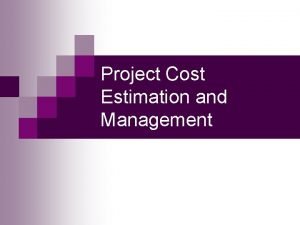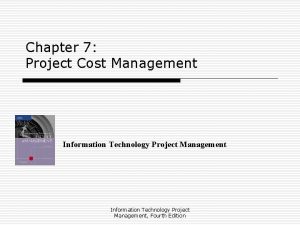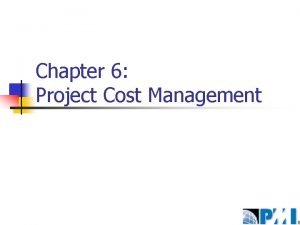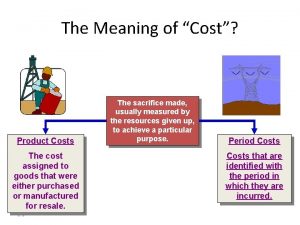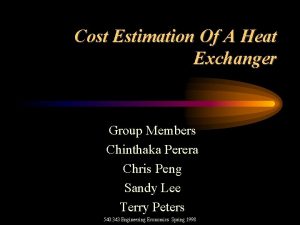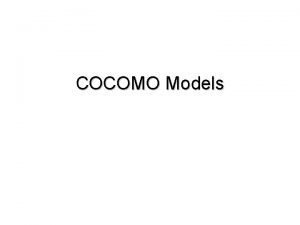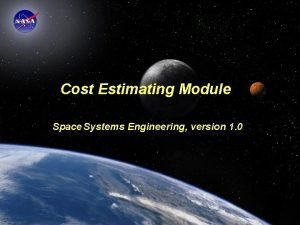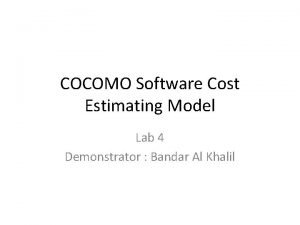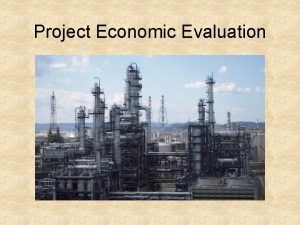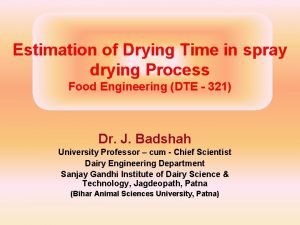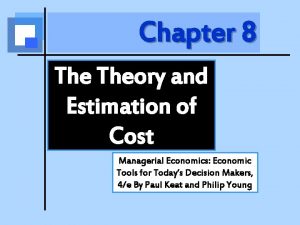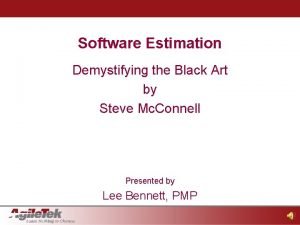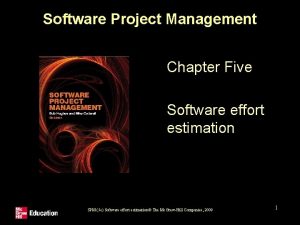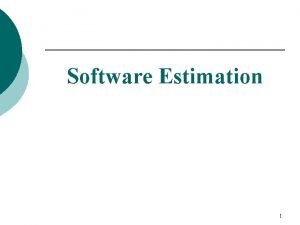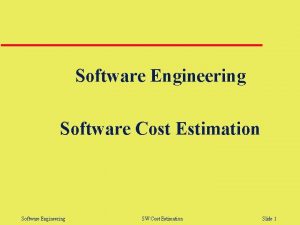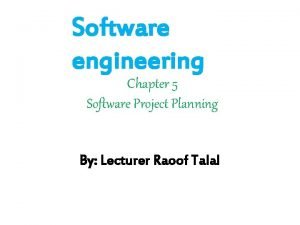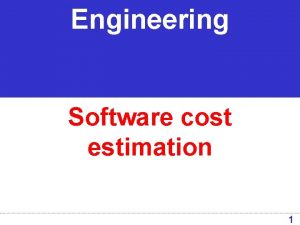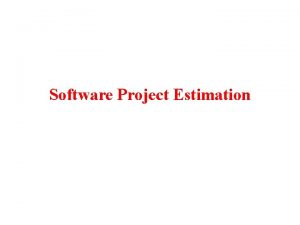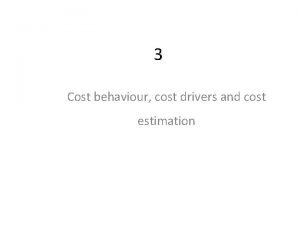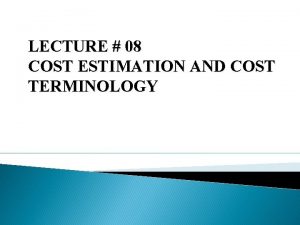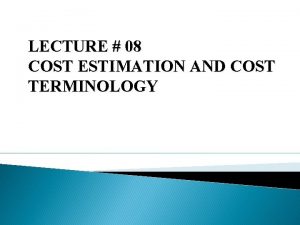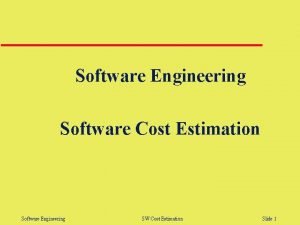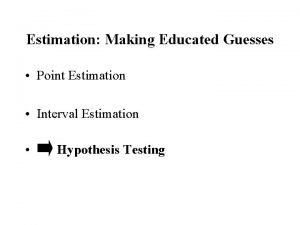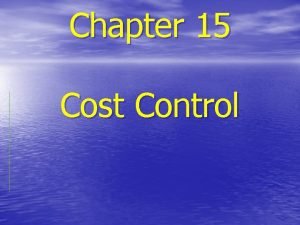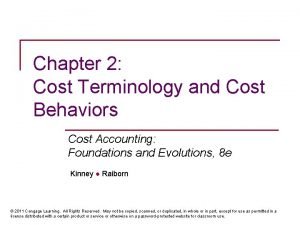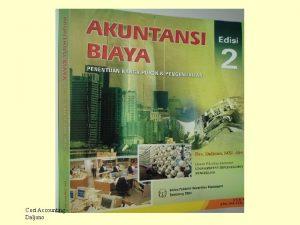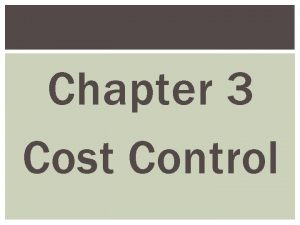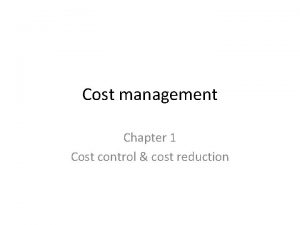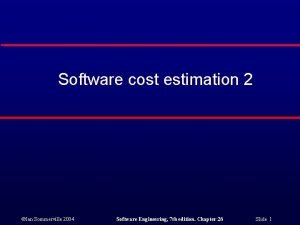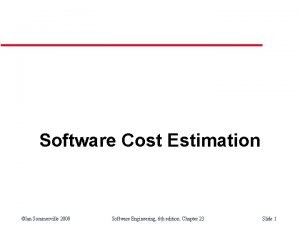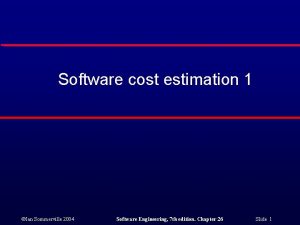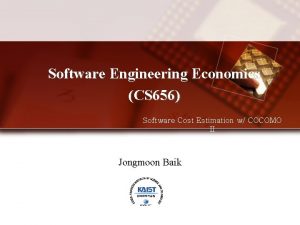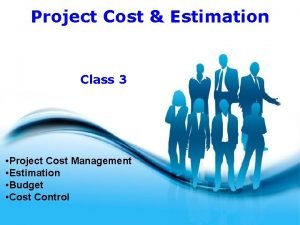Software Development Cost Estimation Chapter 5 in Software































- Slides: 31

Software Development Cost Estimation Chapter 5 in Software Engineering by Ian Summerville (7 th edition) 10/31/2021 1

Outline • Software productivity • Estimation techniques 10/31/2021 2

Fundamental estimation questions • How much effort is required to complete an activity? • How much calendar time is needed to complete an activity? • What is the total cost of an activity? 10/31/2021 3

Software Development Cost Components • Hardware and software costs • Travel and training costs • Effort costs – Salaries of engineers – Overheads • • 10/31/2021 Social and insurance costs Costs of building, heating, lighting. Costs of networking and communications. Costs of shared facilities (e. g. library, staff restaurant, etc. ). 4

Costing vs Pricing • Estimates are made to discover the cost of producing a software system. • Broader organisational, economic, political and business considerations influence the price charged. 10/31/2021 5

Software pricing factors 10/31/2021 6

Software productivity • Is a measure of the rate at which individual engineers produce software and associated documentation. • Is not quality-oriented although quality assurance is a factor in productivity assessment. • Essentially, we want to measure useful functionality produced per time unit. 10/31/2021 7

Productivity measures • Size related measures based on some output from the software process. – Lines of delivered source code – Object code instructions – Number of pages of documentation • Function-related measures based on an estimate of the functionality of the delivered software. – Function-points – Object points 10/31/2021 8

Lines of Code Per Programmer-month (LOC/pm) • LOC/pm is calculated by Total number of lines of source code delivered ------------------------------------Total time in programmer-month to produce the above Where Total time = requirement + design + coding + testing + documentation 10/31/2021 9

Limitations with LOC/pm • The measure was first proposed when programs were developed in FORTRAN, assembly, or COBOL, when programs were typed on cards with one line per card • How does this correspond to statements as in Java, C++? – Multiple line statements – Declaration, executable statements, comments – Macros • What programs should be counted as part of the system? – Prototypes – Testing scripts 10/31/2021 10

LOC/pm limitation across languages • “The lower level the language, the more productive the programmer” – The same functionality takes more code to implement in a lower-level language than in a high-level language. • “The more verbose the programmer, the higher the productivity” – Measures of productivity based on lines of code suggest that programmers who write verbose code are more productive than programmers who write compact code. 10/31/2021 11

Estimation anomalous 10/31/2021 12

Function points • Based on a combination of program characteristics – – external inputs and outputs; user interactions; external interfaces; files used by the system. • A complexity weight is associated with each • Unadjusted function-point count (UFC) is calculated by UFC = Σ(number of elements of given type)x(weight) 10/31/2021 13

• UFC is modified by complexity of the project to produce final FPs for the system. • FPs are very subjective. – – 10/31/2021 Complexity depends on the estimator judgement Complexity depends on the type of system Biased towards data-processing Not suitable for event-driven systems 14

Object points • Object points (aka application points) are an alternative function-related measure. • The number of object points in a program is a weighted estimate of – The number of separate screens that are displayed; – The number of reports that are produced by the system; – The number of program modules that must be developed to supplement the database code; 10/31/2021 15

Object point estimation • Object points are easier to estimate from a specification as they are simply concerned with screens, reports and programming language modules. • They can therefore be estimated at a fairly early point in the development process. 10/31/2021 16

• FPs and OPs can be used to estimate LOC depending on the average number of LOC per FP or OP for a given language – LOC = AVC * number of function (object) points; – AVC is a language-dependent factor 10/31/2021 17

Productivity estimates • Real-time embedded systems, 40 -160 LOC/Person-month. • Systems programs , 150 -400 LOC/Personmonth. • Commercial applications, 200 -900 LOC/Person-month. • In object points, productivity has been measured between 4 and 50 object points/month depending on tool support and developer capability. 10/31/2021 18

Quality vs Productivity • All metrics based on volume/unit time are flawed because they do not take quality into account. • Productivity may generally be increased at the cost of quality. • It is not clear how productivity/quality metrics are related. 10/31/2021 19

Estimation techniques • There is no simple way to make an accurate estimate of the effort – Initial estimates are based on inadequate information in a user requirements definition; – The software may run on unfamiliar computers or use new technology; – The people in the project may be unknown. • Project cost estimates may be self-fulfilling – The estimate defines the budget and the product is adjusted to meet the budget. 10/31/2021 20

Estimation techniques • • • 10/31/2021 Algorithmic cost modelling. Expert judgement. Estimation by analogy. Parkinson's Law. Pricing to win. 21

Estimation techniques 10/31/2021 22

Pricing to win • The project costs whatever the customer has to spend on it. • Advantages: – You get the contract. • Disadvantages: – The probability that the customer gets the system he or she wants is small. – Costs do not accurately reflect the work required. 10/31/2021 23

Pricing to win • May seem unethical and un-businesslike. • However, when detailed information is lacking it may be the only appropriate strategy. • The project cost is agreed on the basis of an outline proposal and the development is constrained by that cost. • A detailed specification may be negotiated or an evolutionary approach used for system development. 10/31/2021 24

Algorithmic cost modelling • Cost is estimated as a mathematical function of product, project and process attributes whose values are estimated by project managers: – Effort = A ´ Size. B ´ M – A is an organisational practice and product constant, – Size is code size or FP or OP – B is a project size factor and reflects the fact that costs don’t increase with size linearly – M is a multiplier reflecting product, process and people attributes. 10/31/2021 25

Estimation accuracy • The size of a software system can only be known accurately when it is finished. • Several factors influence the final size – Use of COTS and components; – Programming language; – Distribution of system. • As the development process progresses then the size estimate becomes more accurate. 10/31/2021 26

The COCOMO model • An empirical model based on project experience. • Well-documented, ‘independent’ model which is not tied to a specific software vendor. • Long history from initial version published in 1981 (COCOMO-81) through various instantiations to COCOMO 2. • COCOMO 2 takes into account different approaches to software development, reuse, etc. 10/31/2021 27

COCOMO 81 10/31/2021 28

COCOMO 2 • COCOMO 81 was developed with the assumption that a waterfall process would be used and that all software would be developed from scratch. • Since its formulation, there have been many changes in software engineering practice and COCOMO 2 is designed to accommodate different approaches to software development. 10/31/2021 29

COCOMO 2 models • COCOMO 2 incorporates a range of sub-models that produce increasingly detailed software estimates. • The sub-models in COCOMO 2 are: – Application composition model. Used when software is composed from existing parts. – Early design model. Used when requirements are available but design has not yet started. – Reuse model. Used to compute the effort of integrating reusable components. – Post-architecture model. Used once the system architecture has been designed and more information about the system is available. 10/31/2021 30

Estimation methods • Each method has strengths and weaknesses. • Estimation should be based on several methods. • If these do not return approximately the same result, then you have insufficient information available to make an estimate. • Some action should be taken to find out more in order to make more accurate estimates. • Pricing to win is sometimes the only applicable method. 10/31/2021 31
 Project cost management lecture notes
Project cost management lecture notes Objectives of cost estimation
Objectives of cost estimation Cost theory and estimation
Cost theory and estimation Surveyor pro project cost estimate
Surveyor pro project cost estimate Objectives of cost management
Objectives of cost management Price structure meaning
Price structure meaning Shell and tube heat exchanger cost estimation
Shell and tube heat exchanger cost estimation Cocomo model cost estimation
Cocomo model cost estimation Satellite cost estimation
Satellite cost estimation Cocomo cost estimation model
Cocomo cost estimation model Structural steel fabrication cost estimation xls
Structural steel fabrication cost estimation xls Cost estimation
Cost estimation Spray dryer cost estimation
Spray dryer cost estimation Estimation of cost function in managerial economics
Estimation of cost function in managerial economics Software estimation demystifying the black art
Software estimation demystifying the black art Software effort estimation in spm
Software effort estimation in spm Software estimation demystifying the black art
Software estimation demystifying the black art Sw cost
Sw cost Project planning software engineering
Project planning software engineering Cost accumulation and cost assignment
Cost accumulation and cost assignment Cost accumulation and cost assignment
Cost accumulation and cost assignment Manufacturing cost vs non manufacturing cost
Manufacturing cost vs non manufacturing cost Job order costing vs process costing
Job order costing vs process costing Flotation cost in cost of equity
Flotation cost in cost of equity Cost concept and classification
Cost concept and classification Cost pools
Cost pools Manufacturing cost vs non manufacturing cost
Manufacturing cost vs non manufacturing cost What is standard costing and variance analysis
What is standard costing and variance analysis Book value of debt
Book value of debt Cost accumulation and cost assignment
Cost accumulation and cost assignment Cost control and cost reduction difference
Cost control and cost reduction difference Standard costs are
Standard costs are

